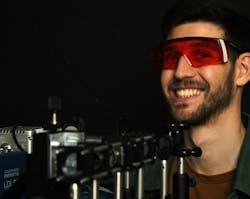Tailored nonlinear metasurfaces generate higher harmonics more efficiently
A Paderborn University (Germany) collaboration between the research groups of Professor Cedrik Meier, Professor Thomas Zentgraf, and Professor Jens Förstner—who specialize in nanophotonics and nanomaterials, ultrafast nanophotonics, and theoretical engineering, respectively—led to a tailored way to generate higher harmonics, which is a precise multiplication of light’s frequency (see video).
Frequency conversion is important to modern optics because it makes it possible to sense light with detectors that would otherwise be “blind” within that wavelength range.
“One example is the detection of infrared (IR) light, which isn’t possible with conventional silicon-based detectors,” says Meier. “By using second- or third-harmonic generation techniques, IR light pulses can be detected with inexpensive photodetectors. But the catch is that many integrated photonics applications require very small and compact frequency-conversion devices.”
The team’s most recent work on dielectric metasurfaces began with numerical calculations that revealed certain combinations of parameters enable extremely high increases in the efficiency of nonlinear frequency conversion processes.
Today, a method commonly used to increase the efficiency of second- or third-harmonic generation processes is to increase the electromagnetic fields of the light source via a pulsed laser.
“Most concepts based on plasmonic or dielectric metasurfaces rely on this method,” says Förstner. “Basically, we create optical modes inside the individual elements of the metasurface, and these modes act very much like standing waves in conventional mechanics or acoustics: they have nodes and anti-nodes within certain regions of the meta-atom.”
The trick is to enhance the electromagnetic fields within these standing-wave patterns as much as possible. “Because high-harmonics generation processes scale nonlinearly with the fields—quadratically or even with the third power—increasing the internal field greatly maximizes the nonlinear light-matter interaction,” he explains.
Third-harmonic generation enhancement
The coolest aspect of the team’s work was discovering a strong third-harmonic generation enhancement emerges from a Fano resonance mode-mixing effect—in which multiple resonances intensify each other. They pulled this off by using tiny elliptical cylinders made of silicon.
“This is very intriguing because it’s spectrally sharp, although the individual contributing resonances it’s made of are much broader,” Förstner points out. “While only two resonances are usually involved, we were surprised to see three modes mixing in our case of extreme third-harmonic generation enhancement. Another nice moment in the lab was when we saw the frequency-converted light as green emission from the sample with our bare eyes upon excitation—the light spot was really bright.”
Experimentally, the biggest challenge for the team was to ensure clean and error-free fabrication of the nanostructures. Since resonances depend on geometry, it’s crucial to get it right.
“If you look at our results very carefully, you’ll see maximum efficiency very strongly depends on the geometry parameters,” says Meier, who led the experimental work. “By very thoroughly analyzing the parameter space in numerical simulations, we discovered this strong effect. On the experimental side, it was similar—the fabrication process window needed to be very tight to match the parameters. And this teaches an important lesson: systematic work is important, because otherwise you can overlook important details.”
Applications for nonlinear metamaterials
While the per-micron conversion efficiency of the team’s metasurface outperforms any natural bulk nonlinear material by orders of magnitude, the absolute conversion ratio of nonlinear bulk materials could be considerably higher simply by increasing the propagation length—which isn’t an option for metasurfaces.
“But we envision several potential applications for nonlinear metamaterials in areas where they can offer the distinct advantages of being extremely thin/small and able to shape the light wavefront—for security applications based on nonlinear holography or ultracompact nonlinear lenses for sensing applications or as part of neuromorphic optical systems,” Förstner says.
The team demonstrated extremely high conversion efficiency for an array of identical elements. “By adjusting each individual element, we can control the transmission and reflection phase—enabling holographic wavefront shaping, for example, to achieve desired deflection angles,” he adds. “Our near-term goal is to achieve such a wavefront manipulation while still maintaining its ultrahigh conversion efficiency.”
FURTHER READING
D. Hähnel et al., Light Sci. Appl., 12, 97 (2023); https://doi.org/10.1038/s41377-023-01134-1.
About the Author
Sally Cole Johnson
Editor in Chief
Sally Cole Johnson, Laser Focus World’s editor in chief, is a science and technology journalist who specializes in physics and semiconductors.

